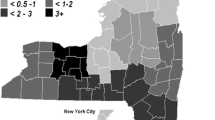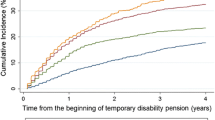Abstract
Purpose The Workforce Innovation and Opportunity Act strengthens the vocational rehabilitation program’s focus on providing early intervention services to keep workers with disabilities in the workforce. At the same time, some have suggested that short-term disability insurance (STDI) programs may hold promise as an early intervention service, helping people with disabilities stay in the labor force and avoid needing longer-term benefits. Rhode Island is one of five states with a mandatory STDI program. We examine the extent to which Rhode Island STDI claimant characteristics are correlated with partial return-to-work (PRTW) benefit receipt and certain STDI benefit receipt duration measures.Methods Our study used administrative data from 2011 to 2014 to explore Rhode Island’s STDI program—called the Temporary Disability Insurance program—and regression analysis to estimate the correlations of interest. Results Regression adjusted estimates revealed that claimants opting to receive PRTW benefits earned more and received benefits for fewer weeks than claimants opting to not receive PRTW benefits. We also observed significant correlations between duration of benefit receipt and claimant characteristics such as diagnosis and treating healthcare provider specialty. Conclusions Findings suggest that STDI claimants with certain characteristics are more likely to receive benefits for a long duration or not receive PRTW benefits, signaling that they might benefit from early Vocational Rehabilitation supports and services that would allow them to remain productive members of the workforce and avoid long term benefit receipt.
Similar content being viewed by others
Change history
26 June 2018
The original version of this article unfortunately contained a mistake in the article title. The text “Rhode Island’s” inadvertently omitted in the original publication.
Notes
The other states with a public STDI program are California, Hawaii, New Jersey, and New York.
The maximum benefit for any claim is 36% of the total base-period wage divided by the weekly benefit rate (not including dependent’s allowance). That amount is equal to 30 full weeks. On rare occasions, the claim period is longer than 30 calendar weeks, but the maximum benefit amount cannot be exceeded.
For a summary of the broader literature on disability and return to work, please see articles such as Carol Cancelliere’s and coauthors’ 2016 systematic review [8].
Because we analyze essentially the entire TDI claimant population during the analysis period, we technically do not need to use statistical inference to understand the proximity of our parameter estimates to the population parameters—our estimates are the population parameters. Nevertheless, we follow convention, reporting standard errors and significance levels.
To examine collinearity in the models, we calculated variance inflation factors. No variance inflation factor we calculated exceeded 3.75.
References
Old Age, Survivors and Disability Insurance Trustees. The 2016 OASDI trustees report. Baltimore (MD): Social Security Administration; 2016.
Social Security Advisory Board (SSAB). A disability system for the 21st century. Washington, DC: SSAB; 2006.
David S, Ben-Shalom Y, Mann D. The employment/eligibility service system: a new gateway for employment supports and Social Security disability benefits. In: McCrery J, Pomeroy E, editors. SSDI solutions: ideas to strengthen the Social Security Disability Insurance program. West Conshohocken (PA): Infinity Publishing; 2016. pp. 51–82.
Bramson K. R.I. increases maximum benefit for temporary disability insurance. Providence Journal. http://www.providencejournal.com/article/20140806/NEWS/308069629. Accessed 6 Aug 2014.
Rhode Island Department of Labor and Training (DLT). TDI/TCI frequently asked questions. Cranston (RI): DLT; 2016. http://www.dlt.ri.gov/tdi/tdifaqs.htm. Accessed 28 Sep 2016.
Work Loss Data Institute. ODG published by Work Loss Data Institute—Work Loss Data Institute publisher of official disability guidelines (ODG). 2016. http://www.worklossdata.com/. Accessed 19 Aug 2016.
Neuhauser F, Ben-Shalom Y, Stapleton D. Early prediction of SSDI entry by California workers: what short-term disability and workers’ compensation claims reveal. Draft manuscript. Washington, DC: Mathematica Policy Research; 2016.
Cancelliere C, Donovan J, Stochkendahl MJ, Biscardi M, Ammendolia C, Myburgh C, Cassidy JD. Factors affecting return to work after injury or illness: best evidence synthesis of systematic reviews. Chirop Man Therap. 2016;24(1):32–55.
Stapleton D, Anfield R, Burns R, Cashdollar W, Doornink B, Gifford B, et al. Targeting early intervention to workers who need help to stay in the labor force. Washington, DC: Mathematica Policy Research; 2015.
Acknowledgements
The authors appreciate the assistance of David Stapleton, Yonatan Ben-Shalom, and Arif Mamun for helpful comments on the analysis; Lisa Shang for programming support; the Rhode Island Department of Labor and Training for providing the data and answering various questions; and the Work Loss Data Institute for providing access to the ODG database. Funding for this study was provided by the Research and Training Center on Employment Policy and Measurement at the University of New Hampshire, which is funded by the National Institute for Disability, Independent Living, and Rehabilitation Research, in the Administration for Community Living, at the U.S. Department of Health and Human Services (DHHS) under cooperative agreement 9ORT5037-02-00. The contents do not necessarily represent the policy of DHHS and you should not assume endorsement by the federal government (EDGAR, 75.620 (b)).
Author information
Authors and Affiliations
Corresponding author
Rights and permissions
About this article
Cite this article
Bourbonniere, A.M., Mann, D.R. Benefit Duration and Return to Work Outcomes in Short Term Disability Insurance Programs: Evidence from Temporary Disability Insurance Program. J Occup Rehabil 28, 597–609 (2018). https://doi.org/10.1007/s10926-018-9779-5
Published:
Issue Date:
DOI: https://doi.org/10.1007/s10926-018-9779-5




